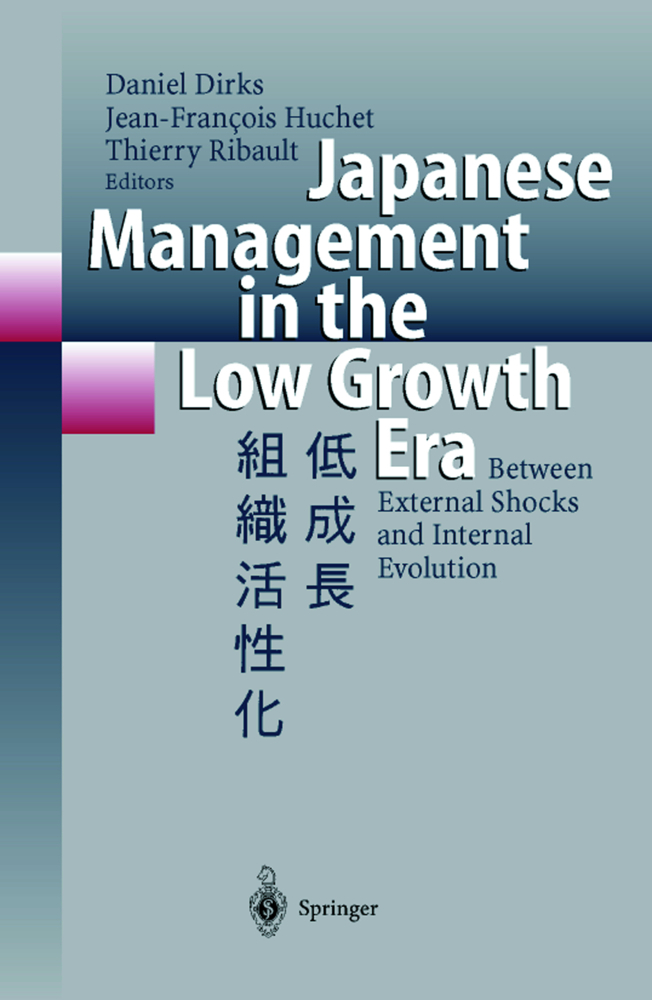Japanese Management in the Low Growth Era
Between External Shocks and Internal Evolution
Japanese Management in the Low Growth Era
Between External Shocks and Internal Evolution
Japanese firms are in the midst of the most protracted economic crisis in their post-war history. The end of the "bubble economy" has led to a long era of low growth. This change in the general business environment has profound consequences for the management and the organization of corporate Japan, as well as for the theory of the Japanese firm. The contributions to this book cover a broad range of subjects, from the strategies and organizational structures to the management of human resources and innovation processes in the 1990s. These changes are systematically commented on by field specialists from abroad, especially Europe, relating the situation in Japan to comparable developments in other countries.
Section 1 Structure, Strategy and Internationalization
I Externalization of Organizations and the Dual Governance Structure
II Role of Inter-organizational Networks: The Case of Japanese Corporate Groups
Commentary: Externalization and Inter-organizational Networks. How Globalization Transforms the Japanese Model
III Modes of Corporate Internationalization: Japanese FDI Strategies in Asia-Pacific
IV Japanese Companies in Europe: Their Strategies and Management Practices
Commentary
Section 2 Corporate Governance and Control
V Presidential Turnover and Performance in the Japanese Firm: The Evolution and Change of the Contingent Governance Structure under the Main Bank System
VI Corporate Pension Schemes, Corporate Pension Governance, and State (De-) Regulation in Japan
VII After Quasi-LBO Discipline: A Historical Reflection on Japanese Corporate Governance
Commentary: From Voice to Exit? Corporate Finance Management and Corporate Governance
Section 3 Industrial Organization
VIII Recession and Globalization: What Future for Japanese Industrial Keiretsu?
IX A Changing Image of Japanese Small Entrepreneurs
Commentary: A New Step in the Evolution of Japanese Industrial Networks?
Section 4 Human Resource Management
X Human Resource Management in Japanese Firms Undergoing Transition: A Hierarchical Approach
Commentary
XI Limits and Latitude of Labour Adjustment Strategies in Japanese Companies
Commentary
XII Flexible Employment in Japanese Retailing: Toward a Just-in-time Employment Management
Commentary: Flexible Employment in Japanese Retailing: Comparisons with Canada and Questions Concerning theSegmentation Theory
Section 5 Innovation and Technology Management
XIII Japanese Corporate R&D in the 1990s: Change and Continuity
Commentary: Japanese R&D Management Practices: The Globalization Challenge
XIV The Phase Variety of Product Systems and System-Based Differentiation: An Alternative View on Organizational Capabilities of the Japanese Firm for Product Innovation
Commentary: System-Based Differentiation in Japanese Firms. Comments from a German Perspective
Section 6 Change and Continuity: On the Transformation of the Japanese Management System
XV Transformation of the Japanese Management System: A Contingency View
XVI Will Japanese and French "Exceptionalisms" Vanish? The Convergence Hypothesis Reconsidered
The Authors.
Managing in a Low Growth Era-The End of Managerial Idiosyncrasies?
Japanese Management Practices in Historical PerspectiveSection 1 Structure, Strategy and Internationalization
I Externalization of Organizations and the Dual Governance Structure
II Role of Inter-organizational Networks: The Case of Japanese Corporate Groups
Commentary: Externalization and Inter-organizational Networks. How Globalization Transforms the Japanese Model
III Modes of Corporate Internationalization: Japanese FDI Strategies in Asia-Pacific
IV Japanese Companies in Europe: Their Strategies and Management Practices
Commentary
Section 2 Corporate Governance and Control
V Presidential Turnover and Performance in the Japanese Firm: The Evolution and Change of the Contingent Governance Structure under the Main Bank System
VI Corporate Pension Schemes, Corporate Pension Governance, and State (De-) Regulation in Japan
VII After Quasi-LBO Discipline: A Historical Reflection on Japanese Corporate Governance
Commentary: From Voice to Exit? Corporate Finance Management and Corporate Governance
Section 3 Industrial Organization
VIII Recession and Globalization: What Future for Japanese Industrial Keiretsu?
IX A Changing Image of Japanese Small Entrepreneurs
Commentary: A New Step in the Evolution of Japanese Industrial Networks?
Section 4 Human Resource Management
X Human Resource Management in Japanese Firms Undergoing Transition: A Hierarchical Approach
Commentary
XI Limits and Latitude of Labour Adjustment Strategies in Japanese Companies
Commentary
XII Flexible Employment in Japanese Retailing: Toward a Just-in-time Employment Management
Commentary: Flexible Employment in Japanese Retailing: Comparisons with Canada and Questions Concerning theSegmentation Theory
Section 5 Innovation and Technology Management
XIII Japanese Corporate R&D in the 1990s: Change and Continuity
Commentary: Japanese R&D Management Practices: The Globalization Challenge
XIV The Phase Variety of Product Systems and System-Based Differentiation: An Alternative View on Organizational Capabilities of the Japanese Firm for Product Innovation
Commentary: System-Based Differentiation in Japanese Firms. Comments from a German Perspective
Section 6 Change and Continuity: On the Transformation of the Japanese Management System
XV Transformation of the Japanese Management System: A Contingency View
XVI Will Japanese and French "Exceptionalisms" Vanish? The Convergence Hypothesis Reconsidered
The Authors.
Dirks, Daniel
Huchet, Jean-Francois
Ribault, Thierry
| ISBN | 978-3-540-64035-6 |
|---|---|
| Artikelnummer | 9783540640356 |
| Medientyp | Buch |
| Copyrightjahr | 1999 |
| Verlag | Springer, Berlin |
| Umfang | IX, 438 Seiten |
| Abbildungen | IX, 438 p. |
| Sprache | Englisch |










